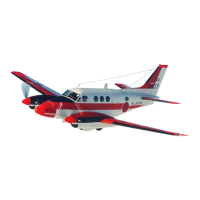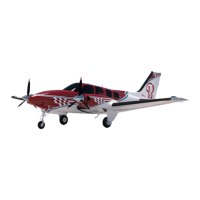Do you have a question about the Beechcraft C23 SUNDOWNER 180 and is the answer not in the manual?
Expresses gratitude for choosing the Beechcraft airplane and highlights design quality.
Emphasizes the need to read the handbook for safe and efficient operation and familiarization with regulations.
Explains the handbook's organization into ten basic divisions for safe and efficient operation.
Details the 'Log of Revisions' for tracking effective pages and revisions to the handbook.
Explains the purpose of the Supplements Revision Record for listing available supplemental equipment.
Discusses responsibility for transferring required STC Supplements when obtaining a new handbook.
Provides a three-view drawing of the airplane with key dimensions and part numbers.
Details ground turning radii for wing tips, nose wheel, inside gear, and outside gear.
Provides specific details about the airplane's engine, propeller, fuel, and oil capacities.
Lists maximum certificated weights for Normal and Utility/Acrobatic categories.
Specifies maximum length, height, and width for the cabin and entry.
Details the compartment volume and door dimensions for baggage.
Provides wing loading and power loading values for a specific weight.
Defines various terms, symbols, and abbreviations used throughout the handbook.
Lists critical airspeeds like Never Exceed (VNE) and Maximum Structural Cruising (VNO/VC).
Describes the color arcs and significant markings on the airspeed indicator.
Details limitations for the engine, operating parameters, fuel, oil, and propeller specifications.
Explains the markings and operating ranges for oil and fuel pressure instruments.
Specifies fuel quantity indications and yellow band limitations for take-off.
Lists maximum certificated weights for normal and utility/acrobatic categories.
Defines forward and aft center of gravity limits for normal and utility categories.
Specifies the datum location relative to the wing leading edge and MAC length.
Outlines approved maneuvers and entry speeds for Normal, Utility, and Acrobatic categories.
Lists the flight maneuvering load factors for flaps up and down in different categories.
Specifies the minimum required flight crew for the aircraft.
Defines the allowable flight operations, including VFR and IFR day and night.
Details FAA equipment requirements for different flight conditions.
Explains the meaning of numbers and symbols used in the equipment requirements table.
Lists required electrical power systems for various flight conditions.
Details requirements for seat belts, shoulder harnesses, and emergency locator transmitters.
Specifies requirements for fire protection equipment, such as portable fire extinguishers.
Describes the requirements for flight control systems like stabilator trim and flap indicators.
Details limitations related to fuel boost pumps, engine driven pumps, and fuel quantity.
Specifies requirements for pitot heat and static air sources for ice protection.
Lists requirements for cockpit, taxi, landing, navigation, and position lights.
Details requirements for altimeter, airspeed, magnetic compass, attitude indicator, etc.
Specifies requirements for vacuum systems used for gyroscopic instruments.
Lists requirements for engine tachometer, exhaust gas temperature, and oil instruments.
Details requirements for oil pressure and oil temperature indicators.
Specifies total fuel capacity and fuel management limitations.
Shows examples of various placards found in the aircraft, including normal and utility category limits.
Lists recommended airspeeds for emergency descent, glide, and landing approach.
Provides procedures for engine failure during take-off, after liftoff, and if no restart occurs.
Outlines checks for rough running engines and loss of engine power.
Details the procedure for attempting an engine airstart.
Provides procedures for engine fires occurring in flight and on the ground.
Describes the procedure for initiating an emergency descent.
Specifies the configuration for maximum glide distance and airspeed.
Details procedures for landing emergencies, including landing without power.
Addresses situations like the starter engaged warning light and alternator failure.
Provides instructions for handling unscheduled electric stabilator trim movements.
Explains the use of the emergency static air source when the normal system is obstructed.
Describes actions to take if a cabin door becomes unlatched in flight.
Details spin entry and recovery procedures, and warnings regarding spins.
Lists critical airspeeds for take-off, climb, cruise, landing, and crosswind.
Provides a detailed checklist for preflight inspection of the aircraft's exterior and interior.
Outlines the steps to take before starting the engine, including seat and belt checks.
Details precautions for using external power for aircraft systems.
Provides procedures for starting the engine using an auxiliary power unit.
Covers normal engine starting procedures, including flooded engine steps.
Lists checks and procedures after starting the engine and before taxiing.
Details the pre-takeoff checks, including seat belts, instruments, and controls.
Describes the procedure for take-off, including power settings and airspeed.
Provides procedures for climbing, including power, temperature, and mixture settings.
Details procedures for cruise flight, including power, fuel boost, and mixture settings.
Explains how to use the EGT to lean the mixture for cruise and best power.
Outlines procedures for descent, including altimeter, carburetor heat, and mixture settings.
Lists pre-landing checks, including seat belts, fuel selector, mixture, flaps, and airspeed.
Provides the procedure for a balked landing (go-around).
Details steps to take after landing, including lights, flaps, and trim tab.
Outlines the procedure for shutting down the engine and securing the aircraft.
Refers to the Systems Description section for heating and ventilation controls.
Covers preflight inspections and engine considerations for cold weather operations.
States that flight in known icing conditions is prohibited.
Provides guidance on engine break-in procedures and oil recommendations.
Discusses noise abatement procedures and the established flyover noise level.
Introduces performance information for flight planning at various aircraft parameters.
Specifies the assumed conditions for performance calculations, including airport data and wind.
Provides notes on airspeed calibration and factors defining performance parameters.
Presents calibration graphs for airspeed indicators in the normal system.
Presents calibration graphs for airspeed indicators in the alternate system.
Provides graphs for altimeter correction based on indicated airspeed and altitude.
Provides graphs for altimeter correction in the alternate system.
Lists power-off stall speeds for various angles of bank at a specific weight.
Illustrates how to determine wind components using a graphical method.
Provides tables for take-off distances on hard surfaces under various conditions.
Provides tables for take-off distances on grass surfaces under various conditions.
Presents climb performance data (rate of climb, airspeed) for various altitudes and conditions.
Provides a chart to determine time, fuel, and distance required for climb.
Details cruise performance data (TAS, fuel flow) at various altitudes and power settings.
Provides tables for landing distances on hard surfaces under various conditions.
Provides tables for landing distances on grass surfaces under various conditions.
Explains the necessity of proper weight and balance computation for safe flight.
Provides instructions for periodic weighing and determining airplane configuration.
Presents a sample form for calculating the basic empty weight and balance.
Provides a form for recording weight changes and maintaining the running basic empty weight.
Outlines owner responsibilities for maintaining weight and balance data and adhering to limits.
Graphical representation of gross weight moment limits for Normal and Utility categories.
Tabulated minimum and maximum moments for various gross weights.
Step-by-step guide on how to compute weight and balance for flight.
A sample loading form demonstrating the method for computing aircraft load.
Provides weights and moments for useful load items like occupants, oil, fuel, and baggage.
Describes the basic airframe configuration and engine power.
Details the standard and optional seating configurations and adjustments.
Explains the operation of control surfaces, column, and rudder pedals.
Describes both manual and optional electric trim systems for pitch control.
Provides illustrations of the typical instrument panel layout for various serial numbers.
Locates and describes the function of master, pitot heat, trim, magneto, and light switches.
States that circuit breakers are located on the right subpanel.
Describes the grouping and location of flight instruments on the panel.
Explains steering mechanism using rudder pedals and nose gear.
Details the operation of manual and electric wing flap systems.
Describes the fixed tricycle landing gear, nose wheel steering, and brakes.
Explains operation of main gear brakes and parking brake control.
Describes the baggage space and hat shelf accessibility.
Covers seat adjustments, seat belt operation, and shoulder harness usage.
Describes the operation of forward cabin doors and the aft baggage door.
Explains the purpose and installation of the control column lock pin.
Details the engine type, horsepower, and operating ranges.
Describes the split-type cowling for engine access.
Explains the engine oil system, capacity, and thermostat bypass control.
Discusses the possibility of carburetor ice and the air preheating system.
Describes the magneto/start switch and the starter engaged warning light.
Specifies the propeller type and static RPM limits.
Details the fuel system, including tanks, drains, schematic, indicators, and pumps.
Explains the single-wire ground-return system, switches, and circuit breakers.
Describes interior and exterior lighting controls and circuits.
Covers cabin heating, ventilation, and exhaust vent systems.
Explains the pitot system, pitot heat, normal and emergency static air systems.
Describes the vacuum system supplying air-driven gyroscopic instruments.
Details the stall warning horn operation and conditions for inoperability.
Outlines requirements for maintaining the airplane in its original manufactured condition.
Lists available technical publications from Beechcraft Aero or International Distributors.
Details FAA required annual inspections and Beechcraft's recommended inspection schedules.
Specifies limited maintenance tasks a pilot can perform, referring to FAR Part 43.
Stresses the need to contact the FAA before alterations to ensure airworthiness.
Provides guidance on safe ground handling procedures, including towing and parking.
Describes procedures for short-term storage, including mooring and securing the aircraft.
Recommends filling fuel cells to capacity to minimize fuel vapor.
Instructs to lock flight control surfaces with internal locks.
Advises to ground the airplane securely and effectively.
Instructs to install the cover on the pitot tube.
Provides guidance on cleaning and waxing windshield and plastic windows.
Outlines steps for preparing the airplane for service after storage.
References manuals for storage procedures for periods longer than 30 days.
Covers maintenance and servicing for fuel, oil, battery, tires, brakes, and engine components.
Provides guidance for minor maintenance tasks like rubber seals, alternator, and magnetos.
Details cleaning procedures for exterior painted surfaces, windows, and interior.
Specifies overhaul or replacement periods for various aircraft components.
Outlines FAA and recommended inspection requirements for the aircraft.
Clarifies that supplemental data is for equipment delivered with or installed on the airplane.
Lists FAA supplements required for flight when specific equipment is installed.
Provides approved maneuvers and procedures for acrobatic flight.
Details the walk-around inspection procedure for the single door C23.
Covers the installation and operation of the Emergency Static Air Source system.
Emphasizes the importance of pilot skill and familiarity with manuals for safe operation.
Covers pilot responsibilities, flight planning, and general safety practices.
Lists FAA regulations, directives, and publications for pilot information.
Provides condensed information on various safety topics relevant to pilots.
Discusses factors affecting pilot performance, including fatigue, hypoxia, and alcohol.
| Manufacturer | Beechcraft |
|---|---|
| Model | C23 SUNDOWNER 180 |
| Type | Light Aircraft |
| Horsepower | 180 hp |
| Wingspan | 32 ft 9 in (9.98 m) |
| Empty Weight | 1, 450 lb (658 kg) |
| Seating Capacity | 4 |
| Engine | Lycoming O-360-A4J |
| Maximum Takeoff Weight | 950 lb (431 kg) |
| Useful Load | 950 lb (431 kg) |
| Fuel Capacity | 50 US gal (190 L) |












